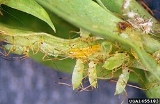
Aphidoletes aphidimyza
Encyclopedia
Aphidoletes aphidimyza is a midge
whose larva
e feed on over 70 aphid
species, including the green peach aphid.
) that live for an average of 10 days, feeding on aphid honeydew. They hide beneath the leaves during the day, and are active at night.
in commercial greenhouse crops. It is supplied as pupae in trays or bottles containing a moist substrate such as vermiculite
or peat
moss for the pupae to complete their development. Once they are placed in the greenhouse they usually emerge from the shipping container as adults to begin egg-laying in 3-7 days depending on temperature.
Midge
A midge is a very small, two-winged flying insect. "Midge" may also refer to:-Real:* Midge Costanza , American politician* Mildred Gillars , aka "Midge", American broadcaster of Nazi propaganda during World War II...
whose larva
Larva
A larva is a distinct juvenile form many animals undergo before metamorphosis into adults. Animals with indirect development such as insects, amphibians, or cnidarians typically have a larval phase of their life cycle...
e feed on over 70 aphid
Aphid
Aphids, also known as plant lice and in Britain and the Commonwealth as greenflies, blackflies or whiteflies, are small sap sucking insects, and members of the superfamily Aphidoidea. Aphids are among the most destructive insect pests on cultivated plants in temperate regions...
species, including the green peach aphid.
Description
The adults are small (less than 1/8 inch long), black, delicate flies (similar to a fungus gnatFungus gnat
Fungus gnats are small, dark, short-lived flies, of the families Sciaridae, Diadocidiidae, Ditomyiidae, Keroplatidae, Bolitophilidae and Mycetophilidae , sometimes placed in the superfamily Mycetophiloidea, whose larvae feed on plant roots or fungi and aid in the decomposition of organic matter...
) that live for an average of 10 days, feeding on aphid honeydew. They hide beneath the leaves during the day, and are active at night.
Life cycle
Females deposit 100-250 tiny (1/64 inch) shiny orange eggs singly or in small groups among aphid colonies that hatch in 2-3 days. After 3-7 days the larvae drop to the ground and burrow 3/4 to 1 and 1/2 inches into the soil to pupate. They are most effective at 68-80º F and high relative humidity.Behavior
The small, bright orange, slug-like larvae inject a toxin into aphids' leg joints to paralyze them and then suck out the aphid body contents through a hole bitten in the thorax. Larvae can consume aphids much larger than themselves and may kill many more aphids than they eat when aphid populations are high. A single larva grows up to 1/8 inch long and kills 4-65 aphids per day.Use in biological pest control
The aphid midge is commercially grown by insectaries for use as biological pest controlBiological pest control
Biological control of pests in agriculture is a method of controlling pests that relies on predation, parasitism, herbivory, or other natural mechanisms...
in commercial greenhouse crops. It is supplied as pupae in trays or bottles containing a moist substrate such as vermiculite
Vermiculite
Vermiculite is a natural mineral that expands with the application of heat. The expansion process is called exfoliation and it is routinely accomplished in purpose-designed commercial furnaces. Vermiculite is formed by weathering or hydrothermal alteration of biotite or phlogopite...
or peat
Peat
Peat is an accumulation of partially decayed vegetation matter or histosol. Peat forms in wetland bogs, moors, muskegs, pocosins, mires, and peat swamp forests. Peat is harvested as an important source of fuel in certain parts of the world...
moss for the pupae to complete their development. Once they are placed in the greenhouse they usually emerge from the shipping container as adults to begin egg-laying in 3-7 days depending on temperature.

